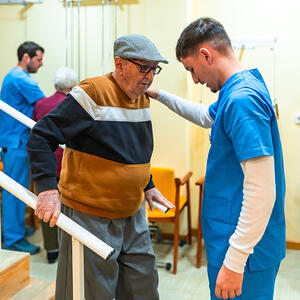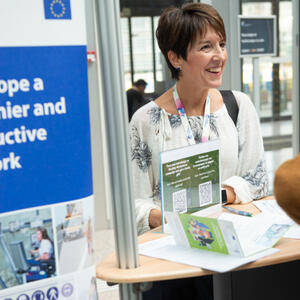A recently published EU-OSHA report Home care workers – a comprehensive overview of occupational safety and health risks examines occupational safety and health in home care, a crucial yet often neglected part of the EU’s health and social care system. It identifies risks like musculoskeletal disorders, psychosocial challenges and poor working conditions, emphasising the...
EU-OSHA's latest findings on mental health in the health and social care sector examine the main psychosocial risks faced by workers across the EU, from long working hours to violence and high emotional burden. In a sector where 72% of workers report dealing with difficult patients and nearly one in two experience time pressure, the studies provide insight into their working...
Wishful Filming, directed by Sarah Vanagt, has won this year’s Healthy Workplaces Film Award for the best work-related documentary. A second film, Vibeke Løkkeberg's The Long Road to the Director’s Chair received an honourable mention. Handing out the top prize, the jury said that Wishful Filming invites reflection on what it means to work and be a worker, and it shows the...
A new EU-OSHA report shows a significant rise in non-fatal accidents in health and social care over the past decade, reinforcing its status as one of the high-risk sectors for workplace accidents. The report provides an overview of accident trends and examines the most common types, offering prevention measures at technical, organisational and individual level. It also includes...
EU-OSHA kicks off the Healthy Workplaces Summit 2025 in Bilbao, bringing together over 400 occupational safety and health professionals, policymakers, social partners, and EU-OSHA’s Focal Point network to explore how digitalisation is transforming work. Across two days of debates, expert sessions, and virtual reality experiences, participants examine the impact of AI...
How has technology affected the way we work in the EU? How does the digital era continue to offer both benefits and challenges to safe and healthy workplaces? Tackling these important questions EU-OSHA is organising its Healthy Workplaces Summit on safe and healthy work in the digital age in Bilbao, Spain on 3-4 December 2025. A dynamic programme of expert-led sessions will...
This World Mental Health Day, our latest OSH Pulse 2025 survey reveals widespread risks to psychosocial health and wellbeing in the workplace. Results show that over 40% of workers report severe time pressure, one in three feel their efforts go unnoticed and nearly 30% experience poor communication or cooperation. EU-OSHA's ongoing work, including its Healthy Workplaces...
Our latest report looks at musculoskeletal health in the health and social care sector, highlighting specific risks and health outcomes, ways to prevent and manage them and the importance of promoting a proactive workplace safety and health culture. It identifies key risk factors - including heavy workloads, manual handling of patients and inadequate training - and presents...
The Healthy Workplaces Good Practice Awards 2025 celebrate organisations that turn digitalisation into opportunities for a safe, healthy, and human-centred world of work. By combining cutting edge digital solutions with proactive safety measures and health programmes, this year’s winners and commended examples demonstrate how digital transformation can become a force for better...
European Week for Safety and Health at Work 2025 is here! Held every October, the week highlights key issues, best practices and innovations from workplaces all over Europe. Find out more on our Healthy Workplaces Campaign 2023-25 website. And EU-OSHA’s current campaign on digitalisation couldn’t be more topical with 32% of workers saying they are using one or more advanced...









